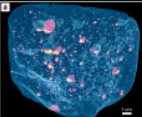X-ray computed tomography of planetary materials: A primer and review of recent studies
X-ray computed tomography (XCT) is a powerful 3D imaging technique that has been used to investigate meteorites, mission-returned samples, and other planetary materials of all scales from dust particles to large rocks.

With this technique, a 3D volume representing the X-ray attenuation (which is sensitive to composition and density) of the materials within an object is produced, allowing various components and textures to be observed and quantified. As with any analytical technique, a thorough understanding of the underlying physical principles, system components, and data acquisition parameters provides a strong foundation for the optimal acquisition and interpretation of the data. Here we present a technical overview of the physics of XCT, describe the major components of a typical laboratory-based XCT instrument, and provide a guide for how to optimize data collection for planetary materials using such systems. We also discuss data processing, visualization and analysis, including a discussion of common data artifacts and how to minimize them. We review a variety of recent studies in which XCT has been used to study extraterrestrial materials and/or to address fundamental problems in planetary science. We conclude with a short discussion of anticipated future directions of XCT technology and application.